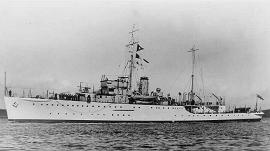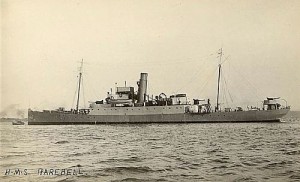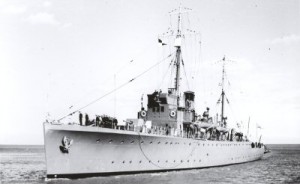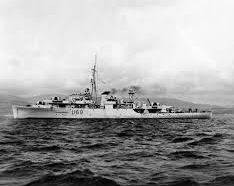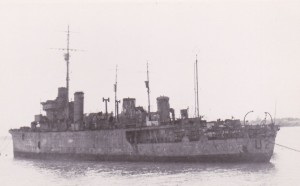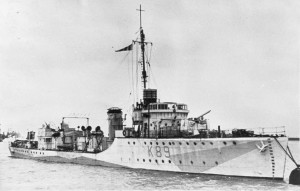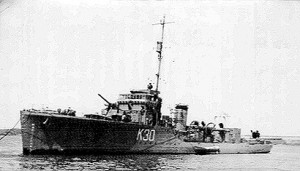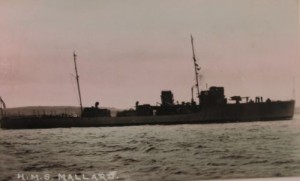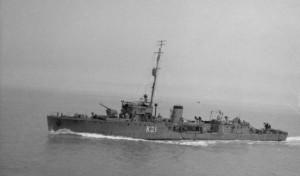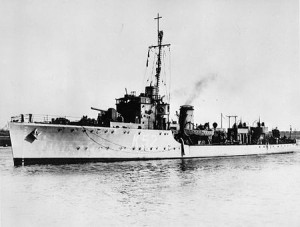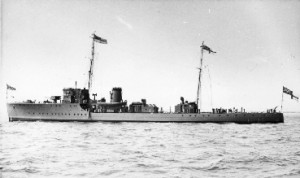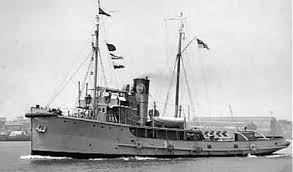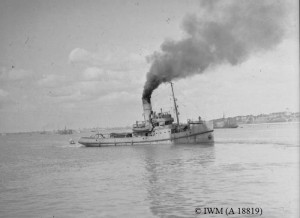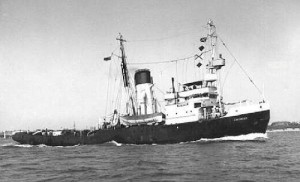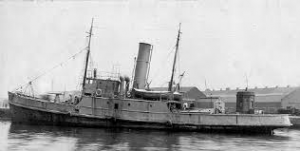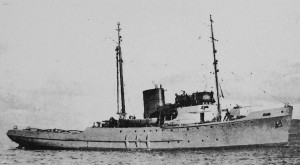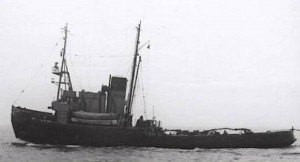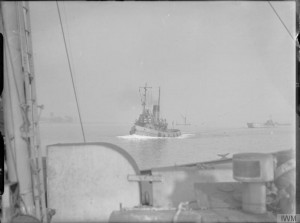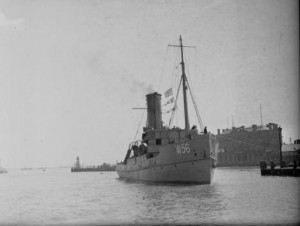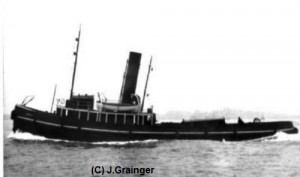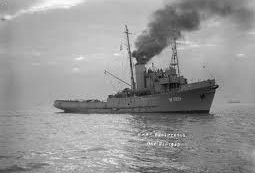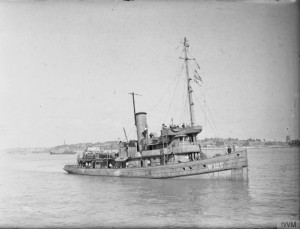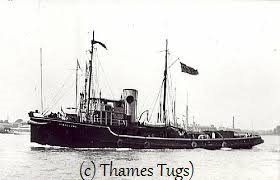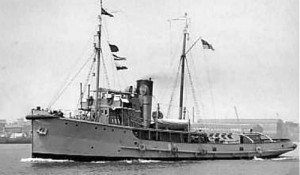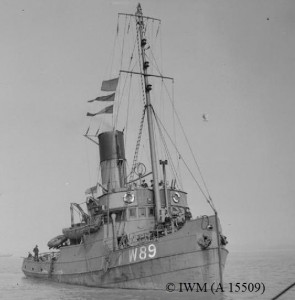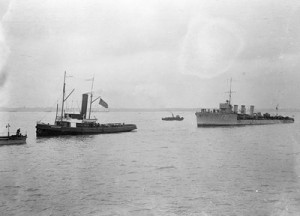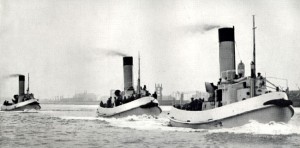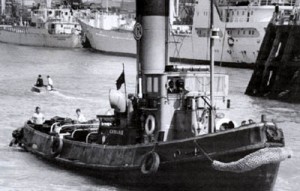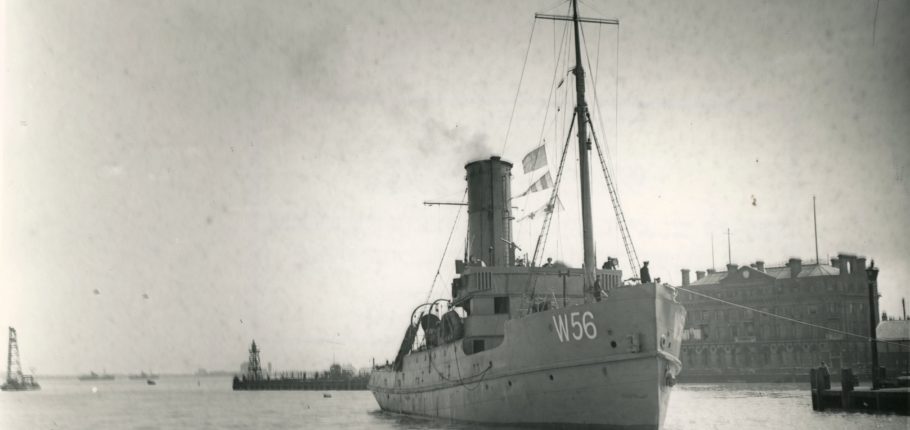
Sloops, Patrol Vessels & Tugs – World War 2
A wide range of smaller ships also served in the Royal Navy in the Second World War. Perhaps not as glamorous as the big guns ships, never the less the Trawlers, Drifters, Tugs and other small ships gave sterling service in many theatres. Some were Navy ships, but most were requisitioned merchant vessels that served under Naval orders during the war.
Sloops.
During the Second World War, 37 ships of the Black Swan class were built for convoy escort duties. However, the warship-standards construction and sophisticated armaments of the sloop of that time did not lend themselves to mass production, and the sloop was supplanted by the corvette, and later the frigate, as the primary escort vessel of the Royal Navy. Built to mercantile standards and with (initially) simple armaments, these vessels, notably the Flower and River classes, were produced in large numbers for the Battle of the Atlantic.
In 1948 the Royal Navy reclassified its remaining sloops and corvettes as frigates (even though the term sloop had been officially defunct for nine years).A Sloop-of-war was a warship that carried up to eighteen guns.
HMS Grimsby
- Type. Sloop
- Class. Grimsby
- Pennant. L16
- Builder. Devonport
- Ordered. 01/11/1932
- Laid Down. 23/01/1933
- Launched. 19/07/1933
- Commissioned. 17/05/1934
- Fate. Sank 25/05/1941
HMS Grimsby was a Grimsby class Sloop launched on the 19th July 1933 by HM Dockyard, Devonport. History: 8th November 1939 – On passage to Harwich, 25th May 1941 – Sunk by German aircraft about 40 nautical miles north-east of Tobruk, Libya.
HMS Harebell
- Type. Sloop
- Class. Anchusa
- Pennant. None
- Builder. Barclay Curle
- Speed. 16 knots
- Ordered. 1916
- Laid Down. 01/02/1917
- Launched. 10/05/1918
- Commissioned. 1918
- Fate. Scrapped 1939
HMS Harebell was an Anchusa Class Sloop launched on the 10th May 1918 by Barclay Curle. History: 19th August 1920 – Arrived Harwich and sailed for Ijmuiden. Fate: Scrapped February 1939.
HMS Hastings
- Type. Sloop
- Class. Hastings
- Pennant. L27
- Builder. Devonport
- Ordered. 4/04/1929
- Laid Down. 29/07/1929
- Launched. 10/04/1930
- Commissioned. 26/11/1930
- Fate. Scrapped 02/04/1946
HMS Hastings was a Hastings-class sloop. She was built by HM Dockyard Devonport, laid down on 29 July 1929 and launched on 10 April 1930. She was completed on 26 November 1930 and commissioned that same day. Hastings was assigned to Rosyth for convoy defence in the North Sea and in waters off the British East Coast from October 1939 until June 1941. In March 1943 she was escorting Convoys HX.229a from St. John’s to Great Britain when the convoy came under heavy and sustained attacks from two German U-boat groups totalling 29 attack submarines. Subsequently, she also escorted Convoy ONS3 and Convoy SC128 whilst they were being attacked by groups of German attack submarines. In August of the same year she took part in many anti-submarine operations. The first was on 23 August off Ortegal, Spain. It was led by HMS Bermuda and lasted for two days. On 25 August, a group of frigates and corvettes arrived in the area but were attacked by 14 Dornier Do-217s, seven Junkers Ju-88s and the new German weapon, the Hs293 glider bomb. The attack was unsuccessful. Two days later, in an operation off Cape Finisterre with RAF Coastal Command led by HMCS Athabaskan, Hastings once again came under glider bomb attack but was undamaged. However, similar glider bombs sunk HMS Egret and severely damaged HMCS Athabaskan, although Athabaskan was saved, the operation was called off. HMS Egret was the fir after being transferred to the 37th Escort Group in September and the 39th Escort Group in October, Hastings was retired at Belfast on 19 November 1943 after comparison of her age and poor record in the field indicated the advantages of using her crew to man newly constructed warships. She was laid-up briefly at Hartlepool before re-fit as a training target for the 3rd Submarine Squadron in Holy Loch from October 1944 until February 1946. She was paid-off on 16 February and was listed for disposal. She was sold for breaking up in April, and arrived at the breaker’s yard at Troon on 10 April 1946 to be broken up by West of Scotland Ship breakers.
HMS Redpole
- Type. Sloop
- Class. Swan
- Pennant. U69
- Builder. Yarrow
- Speed. 20 knots
- Ordered. 27/03/1941
- Laid Down. 18/05/1942
- Launched. 25/02/1943
- Commissioned. 24/06/1943
- Fate. Scrapped 20/11/1960
HMS Redpole was a Modified Black Swan-Class Sloop ordered from Harrow’s of Scott’s, Glasgow in 1940 and laid down on 18th May 1942. The ship was launched on 25th February 1943 by Mrs Mitchell. HMS Redpole reverted to RN control after arrival and was deployed with the British Pacific Fleet at Hong Kong for support of repatriation operations. She remained in the Pacific until returning to UK in 1946 to pay off into Reserve at Harwich. On 12th July 1957 she was involved in a collision with the Gosport Ferry Vadne causing one fatality and badly damaged the Ferry. In1958. The ship was withdrawn from her training role to pay off and was remained in Reserve until 1960. She was sold to Bisco 11th November 1960 for demolition by J A White and arrived in tow at the breaker’s yard at St David’s on 20th November that year.
HMS Scarborough
- Type. Sloop
- Class. Folkestone
- Pennant. L25,U25
- Builder. Swan Hunter
- Speed. 16 knots
- Ordered. 16/02/1939
- Laid Down. 28/05/1929
- Launched. 14/03/1930
- Commissioned. 31/07/1930
- Fate. Scrapped 03/07/1949
HMS Scarborough was ordered on 26 February 1929 under the 1929 building programme and was laid down at the yards of Swan Hunter and Wigham Richardson Ltd., Wallsend-on-Tyne on 28 May 1929. She was launched on 14 March 1930 and commissioned on 31 July 1930 for service in the West Indies.
Scarborough remained deployed on convoy defence into 1941. On 13 March she intercepted the German supply ship Spichern, which scuttled herself. The Spichern had previously been the Norwegian merchant Krossfon, but had been captured by the German auxiliary cruiser Widder in 1940. Also in the spring of 1941, Scarborough intercepted and sank two German-manned ex-Norwegian whalers. These had been captured by the German auxiliary cruiser Pinguin in the South Atlantic and were being sent to German occupied Bordeaux with their valuable cargo of whale oil.
After the end of the war Scarborough was placed on the disposal list and sold to Bisco on 3 June 1949. She was towed to Thornaby-on-Tees and arrived at the breakers yard on 3 July, where she was scrapped.
Patrol Vessels.
A Patrol boat is a relatively small naval vessel generally designed for coastal defence duties. During the war, 486 were constructed, mainly by yacht builders, in the United Kingdom and a number of other allied countries.
HMS Alisdair
- Type. Patrol Vessel
- Class. Kingfisher
- Pennant. 4.3.84
- Builder.
- Speed. 20 knots
- Ordered.
- Laid Down.
- Launched. 1937
- Commissioned.
- Fate. Scrapped 1945
HMS Guillemot
- Type. Patrol Vessel
- Class. Kingfisher
- Pennant. L89, K89
- Builder. William Denny
- Speed. 20 knots
- Ordered. 06/04/1938
- Laid Down. 22/08/1938
- Launched. 06/07/1939
- Commissioned. 28/10/1939
- Fate. Scrapped 1950
HMS Guillemot was a Kingfisher Patrol vessel built by William Denny, Dumbarton and launched on the 6th July 1939. Sold for scrapping 6 June 1950.
HMS Kittiwake
- Type. Patrol Vessel
- Class. Kingfisher
- Pennant. L30, K30
- Builder. Thornycroft
- Speed .20 knots
- Ordered. 21/01/1936
- Laid Down. 07/04/1936
- Launched. 39/11/1936
- Commissioned. 24/04/1937
- Fate. Sold 30/09/1946
HMS Kittiwake was a Kingfisher Patrol vessel by Thornycroft, Southampton and launched on the 30th November 1936. Sold to China on 30 September 1946.
HMS Mallard
- Type. Patrol Vessel
- Class. Kingfisher
- Pennant. L42, K42
- Builder. Alexander Stephen
- Speed. 20 knots
- Ordered. 21/03/1935
- Laid Down. 12/06/1935
- Launched. 26/03/1936
- Commissioned. 15/07/1936
- Fate. Sold 21/04/1947
HMS Mallard was a Kingfisher Patrol vessel built by Alexander Stephens and launched on the 26th March 1936. Mallard was mined on the 30th September 1940 near Harwich and was badly damaged. Repairs lasted to May 1941. she was sold for scrap 21st April 1947.
HMS Pintail
- Type. Patrol Vessel
- Class. Kingfisher
- Pennant. L21, K21
- Builder. William Denny
- Ordered. 06/04/1938
- Laid Down. 23/08/1938
- Launched. 18/08/1939
- Commissioned. 28/11/1939
- Fate. Sank 10/06/1941
HMS Pintail was launched on the 18th August 1939, she was a Kingfisher Class Patrol vessel built by William Denny & Brothers, Dumbarton, Scotland. History: 10 June 1941, the Harwich based patrol vessel HMS Pintail was escorting a convoy near 62-Buoy some 30 miles off the Humber when the steamship Royal Scot detonated an acoustic mine, blew up and sank. Pintail immediately dashed to the scene to help in the rescue, but she was also caught out by an acoustic mine, close to the steamship. HMS Pintail blew up and was lost almost immediately.
HMS Puffin
- Type. Patrol Vessel
- Class. Kingfisher
- Pennant. L52, K52
- Builder. Alexander Stephens
- Speed. 20 knots
- Ordered. 21/03/1935
- Laid Down. 12/06/1935
- Launched. 05/05/1936
- Commissioned. 06/08/1936
- Fate. Scrapped 1947
HMS Puffin was a Kingfisher-class Patrol vessel laid down on 12 June 1935 by Alexander Stephens and Sons, Glasgow, launched on 5 May 1936, and commissioned on 6 August 1936.
On 25 October 1939 the German submarine U-16 was sunk in the English Channel near Dover by depth charges from Puffin and the ASW trawler HMS Cayton Wyke.
On 19 May 1940 Puffin along with a group of six trawlers and two destroyers took part in “Operation Quixote”, cutting commercial cables from the UK to Europe off the coast of Norfolk.
On 26 March 1945 Puffin rammed and sank a German Seehund midget submarine off Lowestoft. The impact caused the U-boat’s torpedoes to explode and Puffin was so badly damaged that she was written off as constructive total loss, and finally sold for scrapping in 1947.
HMS Shearwater
- Type. Patrol Vessel
- Class. Kingfisher
- Pennant. L39, K39
- Builder. J. S. White
- Speed. 20 knots
- Ordered. 1938
- Laid Down. 15/08/1938
- Launched. 18/04/1938
- Commissioned. 07/09/1939
- Fate. Scrapped 21/04/1947
HMS Shearwater was a Kingfisher-class Patrol vessel laid down at J. Samuel White, Cowes on 15 August 1938. She was launched on 18 April 1939 and commissioned on 7 September 1939. She survived the War and sold for scrapping on 21 April 1947. She was broken up by Stockton Ship & Salvage Company.
HMS Sheldrake
- Type. Patrol Vessel
- Class. Kingfisher
- Pennant. L06, K06
- Builder. Thornycroft
- Speed. 20 knots
- Ordered. 21/01/1936
- Laid Down. 21/06/1936
- Launched. 28/10/1937
- Commissioned. 01/07/1937
- Fate. Sold 12/08/1946
HMS Sheldrake was a Kingfisher class Patrol vessel built by Thornycroft, Southampton and launched on the 28th January 1937. Sold to China on 12 August 1946.
HMS Widgeon
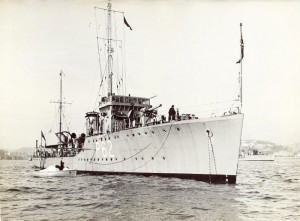
HMS Widgeon
- Type. Patrol Vessel
- Class. Kingfisher
- Pennant. L62, K62
- Builder. Yarrow
- Speed. 20 knots
- Ordered. 13/01/1937
- Laid Down. 08/03/1937
- Launched. 02/02/1938
- Commissioned. 16/06/1938
- Fate. Sold 21/04/1947
HMS Widgeon was a Patrol vessel of the Kingfisher class built by Yarrow Shipbuilders Ltd. (Scotstoun, Scotland) and launched on the 2nd February 1938. Nine patrol sloops of the Kingfisher class were constructed in three groups. Wartime modifications centered on improving air defence and adding radar sets. Some of the first convoys were those along the British east coast, such movements contained many laden deep-sea ships proceeding between ports from Thames to Methil.
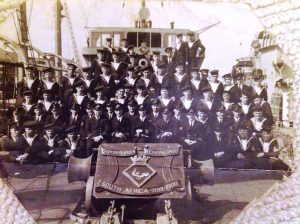
1939
Widgeon and others of its class were based at Harwich for the duration of the war. This port fell under the command of the Commander in Chief Nore. One of the four subdivisions of his command was the base at Harwich, with its shore establishment HMS Badger. Amongst other duties the C-in-C Nore was responsible for the protection of East Coast Convoy Route – used by ships travelling in and out of London and with increasing importance when the German invasion of France made access to Dover limited.
The Kingfisher class were employed exclusively on the east coast of England and based at Harwich. Their speed, high for an escort vessel made them useful against their main adversaries, the E-boat.
HMS Widgeon and her sisters were continuously “watch on – stop on” covering patrols during ‘Operation Dynamo’ the Dunkirk evacuation, east coast convoy escorts, anti-submarine, mine-laying and mine-sweeping, anti-aircraft and anti E-boat duties. Beside her primary duty of defending shipping against U-boat attack, she also had to meet the challenge of enemy aircraft and high speed E-boats.
She was frequently called out to assist damaged merchant ships making for port, and in the search for survivors from sunken ships.
Two were lost in the war, the others were sold or scrapped soon after.
Information and photo supplied by Liam Anderson.
Tugs.
In World War II the Admiralty requisitioned civilian tugs and placed orders for a range of Admiralty tugs. In all 117 harbour tugs were brought into war service,
Admiralty tugs were built to Navy specifications, and standardized where possible to a single design, though this was based on a civilian type. In this they followed the pattern of other auxiliary vessels, such as the Admiralty trawlers, and the Flower class corvettes. They were built by shipyards specializing in tug construction, and thus incorporated merchant rather than navy features, such as an enclosed bridge, and wooden superstructure. However it was specified they be armed and equipped with radio. The First World War vessels had at least one gun, for self-defence, and smoke-generating gear.
The Harwich Harbour tugs towed merchant ships as well as naval vessels, and served Ipswich and Felixstowe as well as Harwich and Parkeston. Some, much larger tugs, some of 1,000 tone and more, were brought to harbour as recue tugs and were for bringing in war-damaged vessels. In practice the harbour tugs helped with this as well – indeed Kenia and Bessie towed more damaged ships than any official rescue tug.
The tugs worked closely with the Salvage Department, commanded successively by Scurr, MacPhee and other Lieutenant Commanders RN or RNR.
Rescue tugs would tow in disabled but still floating ships; salvage vessels would, if possible, raise and patch sunken ones for the tugs to bring in.
HMRT Attentif
- Type. Rescue Tug
- Class. None
- Pennant. W68
- Builder. Forges et Chantiers
- Length. 114.75
- Tonnage. 672 tons
- Launched. 1939
- Commissioned. 1940
- Speed. 16 knots
- Fate. 1964
French Naval Tug based at Harwich in 1944.
07-8-1945 Returned to French Navy.
07-1946 Renamed Locmine.
6-3-1964 Laid up at Brest.
HMRT Caroline Moller
- Type. Rescue Tug
- Class. Saint
- Pennant. W09
- Builder. Livingstone & Cooper
- Ordered. 1918
- Laid Down. 1918
- Launched. 1919
- Commissioned. 1940
- Fate. Sank 07/10/1942
HM Caroline Moller was a Saint Class Rescue Tug launched in 1919 by Livingstone & Cooper. Requisitioned by the Royal Navy during the Second World War and was sunk by German Motor Torpedo Boats off Cromer on 7 October 1942.
HMRT Champion
- Type. Rescue Tug
- Class. None
- Pennant. W35
- Builder.
- Length.
- Tonnage. 672 tons
- Launched. 1939
- Commissioned. 1940
- Speed. 16 Knots
- Fate. 1944
HMRT Champion was attached to the 2nd Light Cruiser Squadron, based at Harwich during 1919.
Empire Race
- Type. Commercial tug
- Class. Birch
- Pennant. None
- Builder. Henry Scarr
- Length. 106.7
- Tonnage. 244 Gross
- Launched. 21/11/1941
- Speed. Knots
- Fate. Scrapped 1991
Empire Race was built by Henry Scarr Ltd, Hessle and sold in 1962 to Società di Navigazione Capiece, Italy and renamed Capo d’Orlando.
1-12-1945 Based at Harwich for handling troopships.
31-8-1958 Returned to the Ministry of Transport.
1962 Sold to Capieci Societa di Navigazione Spa. renamed Capo D’Orlando.
1973 Sold to Italian Navy renamed Ustica
1991 scrapped.
HMRT Enforcer
- Type. Rescue Tug
- Class. Envoy
- Pennant. W177
- Builder. Cochrane & Sons
- Length.
- Tonnage.
- Launched. 22/07/1944
- Commissioned. 01/12/1944
- Speed. 13 Knots
- Fate. Scrapped 1963
There were six Admiralty-designed Fleet Tugs in this Class, three of which saw service as RFA’s. As completed they were armed with 1 x 12 pdr AA gun, 1 x 2 pdr AA , 2 x 20 mm AA and 4 x .303 machine guns. They had a bollard pull of 16 tons and a complement of 33.
22 July 1944 launched by Cochrane & Sons Ltd, Selby, named HMS Enforcer
10 November 1950 sailed Harwich to Torbay arriving 12 November 1950
9 July 1963 purchased for scrap for £6,266 by Jas A. White & Co Ltd, St David’s Harbour, after breaking her moorings and piling up on rocks near the Forth Bridge where she was wrecked.
HM Goole X
- Type. Commercial Tug
- Class. None
- Pennant. YN174
- Builder. J.P. Rennoldson & Sons
- Length. 110′
- Laid Down. 1895
- Launched. 1896
- Commissioned. 21/01/1920
- Fate. Scrapped 1958
British commercial Tug built in 1896 by J.P. Rennoldson & Sons, South Shields. December 1944 Towed barges FB140 and FB159 Gravesend to Harwich. She was returned to her owner on the 13th May 1948 and sold in 1929 to Edmund Handcock Ltd. Cardiff, renamed Falcon. 1958 Scrapped by John Cashmore Ltd, Newport.
HM Growler
- Type. Tug
- Class. Bustler
- Pennant. W105
- Builder. Henry Robb
- Ordered. 1941
- Launched. 10/09/1942
- Commissioned. 16/03/1943
- Speed. 16 knots
- Fate. Scrapped 30/01/1985
HM Growler was a British Bustler class Tug. Built in 1942 by Henry Robb Ltd, Leith, and launched on the 10th September 1942, Delivered to UK Admiralty and employed as convoy rescue tug. December 1944 Towed AFD38 and Compressor barge Gt Yarmouth to Harwich. April 1947 Refitted at Glasgow and Chartered to Moller Towages Ltd. Hong Kong, renamed Caroline Moller. May 1952 Re-chartered by Moller to Hong Kong Salvage & Towage Co Ltd., renamed Castle Peak. 1954 Returned to UK Admiralty, re-renamed Growler Chartered by United Towing Co Ltd., Hull renamed Welshman. 23-10-1963 Returned to Admiralty service at Devonport, renamed Cyclone 1977 Laid up at Gibraltar16-4-1983 Sold to Eagle Tugs Ltd., Georgetown, Cayman Islands, renamed Martial. 30-1-1985 Arrived Gadani Beach, Karachi for scrapping by Adam Hardware Industries, Karachi.
HMRT Jaunty
- Type. Rescue Tug
- Class. Assurance
- Pennant. W30
- Builder. Cochrane & Sons
- Ordered. 1940
- Laid Down. 15/02/1941
- Launched. 11/06/1941
- Commissioned. 07/11/1941
- Fate. Scrapped 21/12/1966
HMRT Jaunty was Assurance Class Recue Tug built by Cochrane & Sons Shipbuilders, Selby and launched on the 11th of June 1941. Jaunty was active in carrying out convoy duty in the English Channel and then took part in towing casions from East India Docks to Beachy Head for what would subsequently be the Mulberry Harbour. HMS Jaunty was assigned to rescue and was on the first wave of the D-Day landings leaving the Solent on 5 June 1944. She played an active part in pre-landings off Arromanches, Normandy. After seven months on the France and Germany campaign Jaunty returned to rescue duty in North Atlantic convoys until the end of hostilities in Europe. She escorted surrendered German U-Boats to Loch Eriboll. In October 1945 she towed a Floating crane to Ceylon and spent the next year in the Far East as part of SEAC. She paid-off at Harwich on January 1947. TID was a standardised British design for a tugboat drawn up and built during the Second World War. One hundred and eighty were built for the Ministry of War Transport.
HMRT Kenia
- Type. Rescue Tug
- Class. None
- Pennant. W47
- Builder.
- Length.
- Tonnage. 200 Gross
- Laid Down. 1927
- Launched. 1927
- Commissioned. 1939
- Speed. 12 knots
- Fate.
HMS Krooman
- Type. Commercial Tug
- Class. None
- Pennant. None
- Builder. Cochrane & Sons
- Ordered. 1937
- Laid Down. 1937
- Launched. 23/10/1937
- Commissioned. 1940
- Speed. 12 Knots
- Fate. Scrapped 1987
Built by Cochrane & Sons Ltd., Selby and launched on the 23-10-1937, Krooman was returned to her owners in 1945 and eventually scrapped in February 1987.
HMS Lady Brassey
- Type. Rescue Tug
- Class. None
- Pennant. None
- Builder. JP Rennoldson
- Length. 39.62 m
- Tonnage. 362 Gross
- Ordered. 1912
- Laid Down. 1913
- Launched. 24/07/1913
- Commissioned. 20/12/1939
- Speed. 12 Knots
- Fate. Scrapped 28/11/1958
HMRT Mammoth
- Type. French Naval Tug
- Class. None
- Pennant. W56
- Builder. Chantiers de L’Atlantique, St. Nazaire
- Speed.
- Ordered. 1916
- Laid Down. 1916
- Launched. 1917
- Commissioned. 1930
- Fate. Scrapped 1964
HMRT Mammoth was a French Naval tug built in 1917 by Chantiers de L’Atlantique, St. Nazaire. Delivered to French Navy, based at Cherbourg. 3-7-1940 Seized by the Royal Navy at Plymouth following the incident at Mers-el-Kebir. 8-1940 Barrage balloon vessels at Sheerness. 1943 Req by Royal Navy for use as salvage tug based Harwich. 1944 Employed as Target towing tug. 12-1944 Towed timber raft Marchwood to Antwerp. 12-1944 Towed LC16 ex Dover to Portsmouth. 15-2-2-1945 Towed 2 pontoons ex Arromanche to Solent. Last towable remains of Mulberry B. 5-6-1945 Released from COTUG control. 17-8-1945 Returned to French Navy. Based Cherbourg pennant R08 later A660. 22-7-1963 Condemned. 1964 Sold for scrapping at Cherbourg.
HMRT Muria
- Type. Rescue Tug
- Class. None
- Pennant.
- Builder. Scott’s Shipbuilding
- Ordered.
- Laid Down. 1914
- Launched. 1914
- Commissioned. 1940
- Speed. 12 knots
- Fate. Sunk 08/11/1940
The tug struck a mine and sank in the North Sea north of Margate, Kent) with the loss of all hands.
HMRT Prosperous
- Type. Rescue Tug
- Class. Assurance
- Pennant. W96
- Builder. Cochrane & Sons
- Ordered.
- Laid Down. 09/03/1942
- Launched. 29/07/1942
- Commissioned. 21/11/1942
- Speed. 14 Knots
- Fate. Scrapped 1980
Launched by Cochrane & Sons Ltd, Selby, and named HMS Prosperous.
1968 purchased by Seka SA, Piraeus and renamed Captain Spyromilios and subsequently saw employment as a Pilot Cutter at Piraeus, Greece.
23 August 1980 arrived at United Shipbreakers, Eleusis to be broken up.
HMRT Saucy (II)
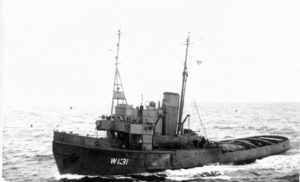
HMRT Saucy II (c) Tony Hall
- Type. Rescue Tug
- Class. Assurance
- Pennant. W131
- Builder. Cochrane & Sons
- Ordered. 1942
- Laid Down. 30/06/1942
- Launched. 26/10/1942
- Commissioned. 27/02/1943
- Speed. 14 Knots
- Fate. Scrapped 1971
British Royal Naval tug built by Cochrane & Sons Ltd. Selby.
26-10-1942 Launched.
27-2-1943 Delivered to UK Admiralty.
1950 Towed HMS Musketeer from Harwich to Liverpool for refit.
1-3-1965 Sold to Tsavliris Salvage and Towage Ltd., Piraeus, renamed Nissos Chios.
1971 Scrapped in Greece.
HMRT Sea Giant
- Type. Rescue Tug
- Class. None
- Pennant. W125
- Builder. Staten Island Shipbuilding
- Ordered. 1919
- Laid Down. 1919
- Launched. 12/01/1920
- Commissioned. 1940
- Speed. 16 Knots
- Fate. 1950
20-8-1920 Delivered to US Navy named Contocook AT-36.
27-11-1933 Decommissioned and laid up at Mare Island Navy Yard, Vallejo, Cal
8-2-1934 Sold to Ship owners and Merchants Tugboat Co., San Francisco.
1938 Renamed Sea Giant.
1940 Purchased by Overseas Towage and Salvage Ltd, London,
4-6-1940 Departed Los Angeles for UK.
1940 Sold to UK Admiralty as rescue tug.
7-1946 Returned to MoWT.
3-5-1948 Sold to Garnet W Stevens, USA.
1950 Deleted from Lloyds Register.
HMRT St. Mellons
- Type. Rescue Tug
- Class. Saint
- Pennant. W81
- Builder. Harland & Wolff
- Length. 135.5 ft
- Tonnage. 422 Gross
- Launched. 30/11/1918
- Commissioned. 30/12/1918
- Speed. 12 Knots
- Fate. Scrapped 1949
St. Mellons was shot down by a Messerschmitt aircraft in the North Sea on the 13th November 1940, salvaged and eventually scrapped in July 1949.
HMRT St. Olaves
- Type. Rescue Tug
- Class. Saint
- Pennant. W40
- Builder. Harland & Wolff (Govan)
- Ordered. 1918
- Laid Down. 1918
- Launched. 27/12/1918
- Commissioned. 1939
- Speed. 12.5 Knots
- Fate. Wrecked 21/09/1942
St. Olaves was grounded and declared a total loss, off Duncansby Head, Scotland on 21 September 1942.
HMRT Superman
- Type. Rescue Tug
- Class. None
- Pennant. W89
- Builder. Cochrane & Sons
- Ordered.
- Laid Down.
- Launched. 1933
- Commissioned. 1939
- Speed. Knots
- Fate. Scrapped 1964
1 Nov 1939: Requisitioned for Admiralty service.
14 Dec 1945: Returned to owners.
Sept 1964 Scrapped at Queenborough, Kent.
HMRT Vanquisher
- Type. Rescue Tug
- Class.
- Pennant. W83
- Builder. J.P. Rennoldson
- Length.
- Tonnage. 179 Gross
- Launched. 1899
- Commissioned.
- Fate. 1941
12-1899 Delivered to Abeille Towage & Salvage, Le Havre, named Abeille No 10.
7-1909 Acquired by Elliott Steam Tug Co., London, renamed Vanquisher.
2-12-1913 Towed Leon Blum, laden with nitrates, Falmouth to Liverpool for £65.
30-7-1914 Ordered to proceed to Sheerness to be requisitioned by RN. Shortly after moved to Harwich.
6-2-1915 Refloated tanker Broadmayne aground off Harwich.
8-3-1915 Renamed Vaunter, serving Harwich.
8-1915 Involved in salvage of mined Bretwalda in Thames Estuary
11-1917 Renamed Vanquisher II.
11-1919 Returned to owners, Renamed Vanquisher II.
28-11-1923 Together with Warrior towing Vernon II, Plymouth to Heybridge Basin. Near Owers LV the tow began to leak badly and eventually capsized and sank with loss of four of the seven runner crew.
2-7-1926 Dry-docked at Nelson Dry Dock, Rotherhithe.
1929 Renamed Vanquisher.
1936-1939 Laid up in Thames.
9-1941 Arrived at T. W. Ward Ltd, Grays Essex, for scrapping.
TID Tugs.
TID was a standardized British design for a tugboat drawn up and built during the Second World War. One hundred and eighty were built for the Ministry of War Transport. In 1943 the Ministry of War Transport decided to introduce a new class of tug. Urgent demands were made for small tugs for harbour and dock work, and to support the impending invasion preparations.
Richard Dunston Ltd. at Thorne on the Stainforth and Keadby Canal and at Hessle on the Humber, had pioneered the use of welded construction, rather than the more conventional riveting, since 1933, although they had never built an all-welded vessel. An order for 12 tugs in 1942 was the opportunity to try such a design. They designed the hulls so that they could be made up from eight separate sections, which were fabricated by manufacturers with spare welding capacity. Shipbuilders with spare capacity were in short supply at the time, but other non-shipbuilding industry was available. Each of the sections was a maximum of 10 feet (3.0 m) by 17 feet (5.2 m) by 13 feet (4.0 m), and weighed less than 6 tons, so that they could be transported by road to the Thorne yard. At the yard, the sections were fitted together by welders, many of whom were women, and the engines were installed. The first tug was ready for dispatch in February 1943, and for more than a year, one left the yard every five days.
TID 30
- Type. Tug
- Class. Tid
- Pennant. TID30
- Builder. Richard Dunston Ltd
- Completed 08/06/1943
- Launched. 08/06/1943
- Commissioned. 1943
- Fate. Sank 1979
TID 30 was built in 1943 by Richard Dunston Ltd., Thorne and Launched on the 8th June 1943. Harwich. July 1944 Transferred to US Army 329th Harbour Craft Coy. June 1979 Sank off Kemi after propeller shaft had broken.
TID 64
- Type. Tug
- Class. Tid
- Pennant. TID64
- Builder. Richard Dunston Ltd
- Completed. 1944
- Launched. 25/01/1944
- Commissioned. 1943
- Fate. Scrapped 1969
Launched 25th January 1944. and scrapped Harwich in 1969.
TID 107
- Type. Tug
- Class. Tid
- Pennant. TID 107
- Builder. Richard Dunston Ltd
- Length. 21.87 m
- Tonnage. 54 GRT
- Completed 10/11/1944.
- Launched. 12/08/1944
- Commissioned. 1944
- Fate. Scrapped 1976
Launched 12th August 1944. allocated to Captain in Charge, Harwich.
1948: Admiralty – Harwich and Chatham.
30.12.1957: Transferred to Captain of Dockyard, Chatham.
5.1.1968: sold for breaking up T.W. Ward Ltd,
1970: Christiani & Nielsen Ltd.
1973: B. Pearce, Maldon, Essex.
12.1976: Scrapped in Milton Creek, Sittingbourne, Kent.
We are adding more information to this site on a regular basis, if you wish to submit any photos or provide any information on naval vessels that were based or visited Harwich, then please use the contact page at the bottom of the screen.
← Torpedo Boats – World War 2 Sloops, Drifters & Monitors – World War 1 →